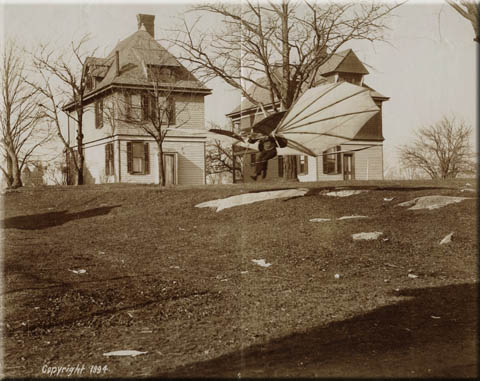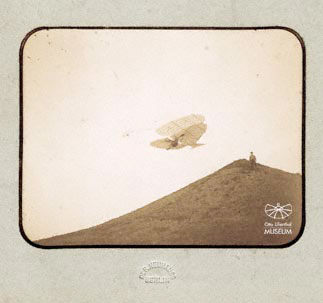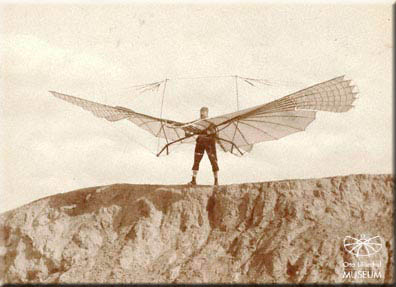Published in a similar form in: "One Hundred Years of Powered Flight 1903 - 2003"; The Winchester Group, London, 2003
From Lilienthal to the Wrights
Bernd Lukasch
"No one equaled him in power to draw new recruits to the cause; no one equaled him in fullness and dearness of understanding of the principles of flight; no one did so much to convince the world of the advantages of curved wing surfaces; and no one did so much to transfer the problem of human flight to the open air where it belonged.
As a missionary he was wonderful. He presented the cause of human flight to his readers so earnestly, so attractively, and so convincingly that it was difficult for anyone to resist the temptation to make an attempt at it himself, … he was without question the greatest of the precursors, and the world owes to him a great debt."
With these words in 1912, Wilbur Wright described the man who was the most important influence on practical flying and flight theory before the Wright brothers: the German engineer, Otto Lilienthal.
In the period from 1891 to 1896, Lilienthal succeeded with over 2,000 gliding flights with many different glider designs, including flapping wing models (ornithopters). His total of five hours flying time was probably the most important in aviation history. The basis for his flying experiments resulted in the book he published in 1889 after over 20 years of research. He discussed the basic principles of the curved wing, its description, its possible measurements, and stressed the importance of actually flying outdoors.
The Wrights stated later that it was the news of Lilienthal’s death that stimulated them, to focus their interest on the problem of flight. They contacted the American authority of knowledge about worldwide flight research, Octave Chanute, the publisher of the section “Aeronautics” in the ”American Engineer and Railroad Journal”. Chanute exchanged correspondence with Lilienthal for several years. His book, “Progress in Flying Machines,” included Lilienthal’s latest article as an appendix. Chanute translated parts of Lilienthal’s book and became the scientific link between Lilienthal and early aviation development in the United States. As a matter of fact, Lilienthal was the only person in the world able to fly repeatedly and reliably during the period when the Wright brothers started their flight research.

Construction of a Lilienthal glider in the United States, 1894 by A. Herring
Picture from Lilienthal's estate
Otto Lilienthal was born in Anklam/Germany on 23 May 1848, as the first of eight children of the cloth trader Gustav Lilienthal. The financial situation of his family became more and more difficult from year to year, so the family decided to emigrate to America. But Lilienthal's father died unexpectedly, when Otto Lilienthal was 12 years old. It was a decision of his uncle and guardian for Otto to study mechanical engineering in Berlin at the new founded Royal Technical Academy.
To study the flight of birds, especially the flight of the white stork was a life long topic of interest to the two Lilienthal brothers, Otto and one year younger Gustav. In 1873 Gustav registered both brothers as members of the Aeronautical Society of Great Britain. In the same year Otto Lilienthal gave his first public lecture about the theory of the flight of birds in Germany. Especially in two time periods in the year 1874 and 1888, the brothers experimented and researched systematically the forces of air on artificial wings and on the characteristics of natural wind using models and kites.
In 1877, Lilienthal submitted a patent on a machine used in mining - the first of 25 patents by Lilienthal (among them were four aviation patents). In 1883 he founded his own mechanical engineering company for steam boilers and engines in Berlin.
In 1886 he became a member in the "Deutscher Verein zur Förderung der Luftschiffahrt" (German Club for Promotion of Aviation) in Berlin. Three years later he published his book "Der Vogelflug als Grundlage der Fliegekunst" ("Bird Flight As The Basis Of Aviation" - English translation 1911).
A short time later he introduced a 25% profit sharing scheme for the workers in his company that became the first flying machine factory in the world.
In 1890 Lilienthal began to experiment with man-carrying flying machines. Within one year, he succeeded with first jumps and flights covering a distance of about 80 feet near the villages of Derwitz and Krilow just outside of Potsdam. Besides improving glider construction and glider flying, as well as his very innovative work in the field of steam engines, Lilienthal became very interested in the Berlin 'Volkstheater' (people's theatre) –movement (1892).
In 1893, Lilienthal constructed a "flight station" near his home and began his flight experiments in the "Rhinow Hills," his favourite practice area for gliding up to a distance of about 800 feet. He began construction of several flying machines, among them a flapping wing machine driven by a carbon-acid engine. For the purpose of training and testing of new aircraft closer to his home and factory, Lilienthal built his so-called 'Fliegeberg' (Aviation Hill) that still exists in Lichterfelde, at that time a suburb (today a district) of Berlin. This was his second "airfield" with a glider hangar on the top of the hill.
In 1894 Lilienthal started serial production of the so-called "Normal-Glider". With one exception (Vienna) all original Lilienthal gliders that exist today are production models from this series (Washington, London, Moscow, Munich).

Flight using big Biplane with the "Aviation
Hill" in the background, October 7, 1895
In 1895 engineers and scientists from around the world came to Germany and visited Lilienthal, among them S. P. Langley, Secretary of the Smithsonian Institution in Washington and N. J. Shukowski, aerodynamics expert from Moscow.
Lilienthal’s dramatic demise after a crash on August 9, 1896 was an accident on a routine flight with a standard glider. Steering with body shifting through a strong thermal did not succeed. The period of successful flights and then the accident demonstrated his flight concept and its limited steering ability. It is symbolic for his success but also for his limitation.
Lilienthal's worldwide fame is based on his successful flights. Today, we look at his controlled and reproducible glides in 1891 covering a distance of 80 feet as the beginning of successful human flight. After 1893, Lilienthal was able to cover distances of about 800 feet in the Rhinow Hills. These accomplishments were not surpassed prior to his death in 1896 by anyone.
These first practical successes were the outcome of a
research program on which he worked with great determination
and creativity for more
than 20 years. Today we call his research "the
beginning of aerodynamics".
It was only after he had presented his full experimental research
and interpretations in his book that he started to construct
man-carrying
flying machines. Some of his works and discoveries in the physics
of flight should be highlighted:
- The conclusive account of the fact, that the mechanical work in order to lift a body in still air is fundamentally different from the flight effort of birds;
- The experimental account of the advantages of the curved wing surfaces and the attempt to interpret the results through streamlines;
- To separate the resultant air force in its lift and drag components;
- The analysis of the results still used in the same way today: the "polar diagram";
- The analysis of different wing designs and first statements about aspect ratio, wing shape and profile were partly proved by experiments and partly by intuition.
- The development and use of very simple measuring devices, which supplied the first actual available measurements of ratio and direction of the resultant force of the air. This was successful because of the size of the apparatus by which some measuring mistakes became irrelevant. The most important measuring devices were different whirling arm apparatus (aerodynamic balance) and an instrument for measuring the force of air currents in natural wind.
Lilienthal defined his research an impressive conclusion:
"All flight is based upon producing
air pressure,
all flight energy consists in overcoming air pressure."
One of the most important sources of our knowledge, about Lilienthal's flight technique, is the great number of remaining photographs. The 137 known photos from the period from 1891 to 1896, which were made during Lilienthal's flight tests, not only document the aviation history but also the history of photography. Because of sensitive film material and high shutter speed for the "momentum (action) photography", the production of "moving pictures" was a preliminary stage for motion pictures (the movies).
Lilienthal asked photographers regularly to help document the development of his flight technique. Most of his photographers (probably all) are well known.
Most of the pictures are excellent quality. Lilienthal used the most beautiful pictures in his annual reports. Today, large collections of these impressive pictures are in the Deutsches Museum in Munich and in the Otto-Lilienthal-Museum. But Lilienthal was aware of the unrealistic impression of these photos, when he said in one of his lectures:
"At the end I want to ask you not to take my achievements for more than what they are. Through the photographic pictures, where you can see me flying high above in the sky, one can get the impression that the problem is already solved. That is not at all the case. I have to admit that it will still take quite a lot of work to turn this simple gliding flight into long distance human flight. The achievements so far for human flight are nothing more than were the first insecure steps of a child related to the walking of men." (Otto Lilienthal in a lecture in November 1894).
But these pictures clearly show: Lilienthal did solve the initial problem of flight, i. e. he found the source of the necessary lift for human flight. But there were two other problems he did not solve. The solution of these problems, in the evolution of the invention of the flying machine came through the research of the Wright brothers:
First: The steering of the aircraft with Lilienthal's method of shifting the centre of mass was not sufficient in his glider design for non-standard or dangerous situations. The maximum weight shift was not large enough in comparison to the size of the glider.
Second: Lilienthal's driving force concept was the concept of wing flapping. Today, we know, that wing flapping as the birds do, has not been realized as a successful technique. Possibly this situation may change in the future, but for the birth of the aircraft this concept was not successful.

Small wing flapping apparatus,
August 16, 1894
But nevertheless, the first step towards the design of the aircraft was realized successfully between the years of 1891 and 1896, repeated human flight with artificial wings from the top of a hill to the ground over a distance of about 800 feet.
The Otto-Lilienthal-Museum celebrated the 150th birthday of Otto Lilienthal in 1998 with a conference about the influence of Lilienthal on the work of the Wright brothers and about Octave Chanute. During this conference Werner Schwipps presented his book: ”The Wright Brothers and Their Aircraft in Germany” (Otto-Lilienthal-Museum Anklam, 1998/2013, available in German only). This is the first publication about the Wright factory in Germany, at that time the most successful one in Europe, and the outstanding role of the Wright brothers on the development of aviation in Germany.
